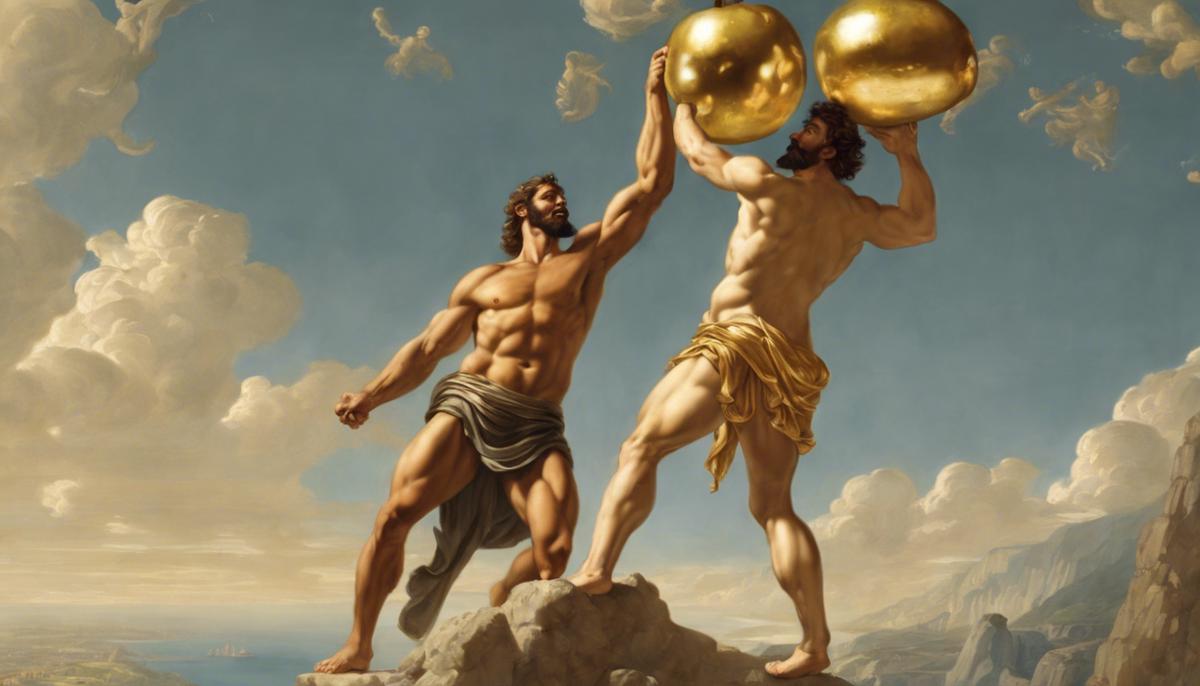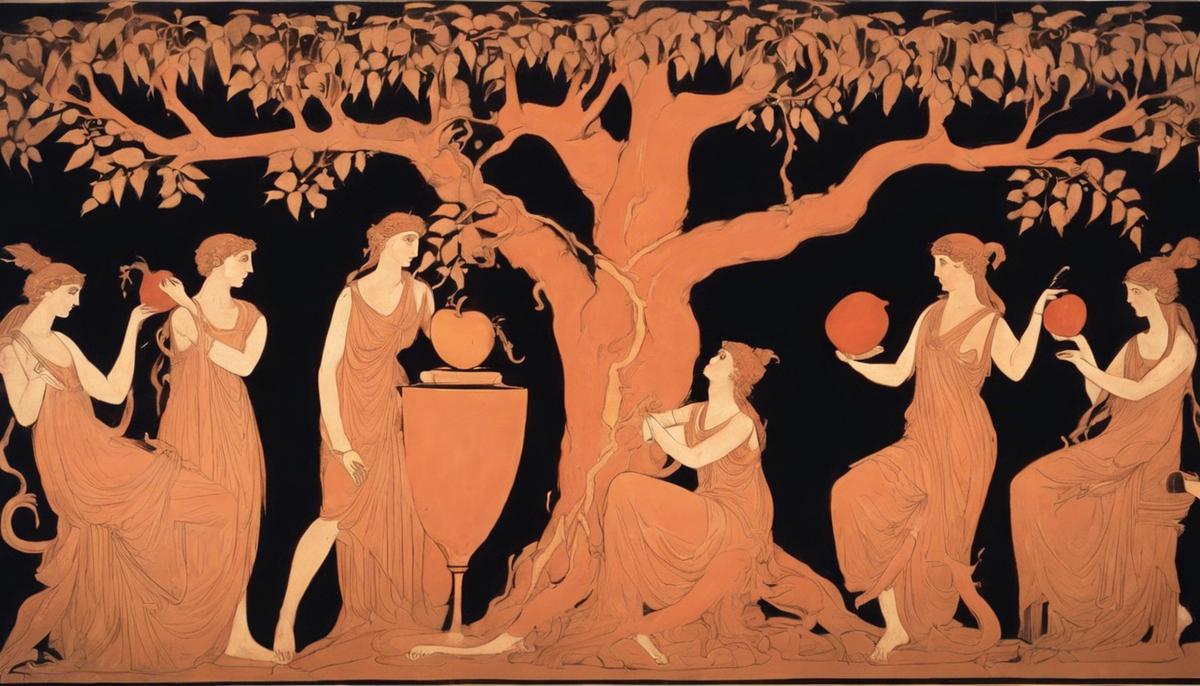Origins and Parentage
The parentage of the Hesperides varies across ancient texts. In Hesiod's version, they are daughters of Nyx, the night herself, without any father mentioned. This account emphasizes the mystical aspects of evening, adding a dose of intrigue to the Hesperides' narrative.
In Diodorus' works, the sea nymph Hesperis and the Titan Atlas are introduced as the parents. This narrative paints a more wholesome picture, with Atlas, the mighty bearer of the heavens, as their father.
To add some confusion, there are accounts that mention Phorcys and Ceto, a pair related to sea monsters, or Zeus and Themis as potential parents.
The variance in parentage adds zest to these tales and projects different vibes onto the Hesperides. Hesiod's version hints at a somber, ethereal lineage, while Diodorus paints a celestial picture.
The number of Hesperides also varies, from three in Homeric hymns to four or seven elsewhere, altering their group dynamic and individual significance.
Through these varying narratives, the Hesperides stand as symbols beyond mere characters in myth. Whether they're night-born or star-kissed children of Atlas, their story threads through Greek mythology like gold light through the evening sky.
The Golden Apples
The Golden Apples of the Hesperides aren't your everyday fruit; they are swathed in divine intrigue and guarded by Ladon, a hundred-headed dragon.
These celestial apples were presented as a wedding gift from Earth (Gaia) to Hera, queen of the gods, on her union with Zeus. They represented an interest so profound that it fostered heists led by deities and heroes alike.
The apples symbolized eternal life and sublime attraction. They were potent icons of the idea of endless youth, an escape from mortal decay.
Ladon's duty to guard these fruits sheds light on the concept of temptation. The formidable dragon watchers set to handle precious trees producing otherworldly fruit is like saying, "I dare you," without moving a lip.
Every narrative involving these golden apples taps into that human (and godly) itch—the grasping for what is tantalizingly out of reach. Princess Atalanta, for example, was distracted in her race by golden apples and, despite her swiftness, lost to cunning Hippomenes.
Despite the efforts to acquire these apples, they're repeatedly returned to their original spot either by necessity or divine will. Hercules fetched these apples as one of his labors but returned them after his Herculean efforts.
The golden apples create storylines laced with humor and irony. They raise the question: is immortality wrapped in gold always worth the chase?

Mythological Roles and Stories
Hercules' eleventh labor involves snatching the golden apples guarded by Ladon. This adventure dives into themes of challenge, deception, and the hustle for divine favor.
Hercules first wrestles with knowledge, capturing the shape-shifting sea god Nereus to extract the path to his fruity goal. He then meets Atlas, the Titan holding up the sky, and strikes a deal: Hercules holds the sky while Atlas fetches the apples.
However, Atlas tries to trick Hercules into a permanent role swap. Hercules, crafty as he is brawny, tricks Atlas back into his celestial gig and takes the apples back to Eurystheus.
This narrative is rich in themes like deceit, endurance, and cunning. It interlocks with broader Greek mythology highlights: heroism under duress, the whims of gods, and the plight of mortals and immortals striving within their fated confines.
The story resonates because it mirrors the virtues and vices as timeless as Nyx's star-studded cloak. It echoes all shades of human spirit in these legends.
During Hercules' adventures, he also liberates Prometheus, who was chained for snagging fire for humanity, by shooting Zeus's eagle with a well-placed arrow.
The Hesperides orchestrate the melody of Greek mythology's exploration of mortal aspiration against divine decree. Such tales underscore the dance on the knife-edge between human limitation and the hunger for boundlessness.

Cultural and Artistic Representations
In artistic works, the Hesperides embody divine symbolism. They are frequently found in detail-drenched works like Athenian red-figure vases, carrying the essence of early evening secrets and divine playfulness.
Scenes depicting these nymphs stationed around the serpent-entwined apple tree are testament to their role as custodians of celestial agriculture and their integral duty in maintaining cosmic order.
The regular feature of the serpent Ladon teeming through the branches and roots casts a glimpse into the Greek fixation on regeneration and eternal life.
These portrayals illustrate the lush fabric of property guarded by divine decree. They echo the philosophical pulse of the era that pondered deeply on boundaries—what one can own, what one must protect, and what inevitably slips away.
Beyond visual arts, the Hesperides also feature in poetry. Poets from Hesiod to Apollonius have threaded their texts with glimpses of these nymphs, securing their mythos within the loom of Greek cultural narrative.
Their movement from mythic margins to the limelight of scenic arts speaks to their escalated status as symbols of immortality's gatekeepers, entrusted with treasures transcending golden allure to anchor heavenly powers.
In artistic depictions, the Hesperides are seen not just as chorus members of creation but central figures presiding over divine legacies. They remind us of the fundamental imprints of mythology on cultural consciousness.
Through the dramatic portals of ancient amphorae to the subliminal narratives of odes, their artistic rendition furnishes not just walls or pages, but minds tuned to appreciate an elegance birthed at twilight.

In the grand narrative of Greek mythology, the Hesperides are pivotal in shaping the contours of mythic storytelling. Their tales, rich with allegorical depth, challenge us to reflect on our own pursuits and the lengths we go to in chasing what we deem precious. Through their enduring legacy, these nymphs continue to inspire and provoke thought about the nature of desire and the essence of what it truly means to guard something invaluable.
- Hesiod. Theogony. Translated by Hugh G. Evelyn-White. Harvard University Press, 1914.
- Diodorus Siculus. Library of History. Translated by C. H. Oldfather. Harvard University Press, 1933.
- Pseudo-Apollodorus. Bibliotheca. Translated by James George Frazer. Harvard University Press, 1921.
- Pausanias. Description of Greece. Translated by W. H. S. Jones. Harvard University Press, 1918.
- Apollonius Rhodius. Argonautica. Translated by R. C. Seaton. Harvard University Press, 1912.

Leave a Reply